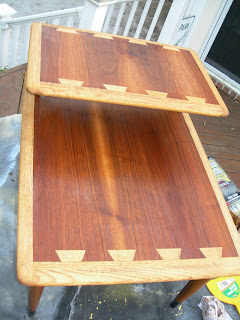Perish the thought, but, in the 1920's and 1930's homes did not have closets.
Can you imagine?
People didn't have elaborate amounts of clothing that required walk-in closets
and homes did not typically have closets built in.
The solution was the piece of furniture known as the wardrobe.
Wardrobes came in many shapes and sizes. In the 30's, Art Deco was king. I am particularly fond of the Art Deco Waterfall style. The Waterfall style is characterized by a rounded front on top of the furniture piece mimicking a waterfall.
Typically, waterfall pieces are veneered. Because it is veneer, you will often see damage on the pieces you find at yard sales or estate sales. Stripping and refinishing is tricky because if you strip and sand it, you might go right through the thin veneer and get down to the base wood.
So what if you like the style and form of the piece but it is damaged and can't be re-stained? What if your style is sleeker and more modern? How about painting it!
I see a lot of old waterfall furniture that is painted. You've probably seen pieces in magazines painted off white or cream and turned into beautiful "shabby chic" pieces. You also see lots of them used in "cottage" design. I like the way they turn out but, for me, Deco should be sleek and the shabby chic and cottage look just don't work for me.
What to do, what to do! For me, it is to go black. Not shiny gloss but an eggshell finish of black. Eggshell finish is not totally flat but also not like a high gloss finish. If you go to the paint department of your local paint store or Home Depot or Lowes and ask them to show you the different finishes they have available you'll see the differences and then you can pick what you like. For me, it is always eggshell when I paint furniture.
Right about now, purists are screaming at their computer screen and pulling their hair out . How can you "paint" furniture? That ruins the value and integrity of the piece. Well, they are right. If you start with a piece that is pristine and valuable, painting it will ruin its value. But if you are starting with a piece that is not in the greatest shape and you are not purchasing it to preserve it as an investment or it is not a family heirloom, then whats the problem? I would never paint a piece of waterfall deco furniture that is in mint condition and I have many in my home that are original. They were mass produced and don't carry high values but I love them in their original finish and thats all that matters. But when I come across a piece that is in rough shape, painting is the way to go.
Here is my deco waterfall wardrobe project.
I paid $25.00 for this wardrobe at a yard sale.
As you can see, it has water stains on top, someone carved their name into it
and generally it is in rough shape.
I took it apart, re-glued the drawers to tighten them up,
puttied the breaks in the veneer and sanded it all.
I am lazy so I have a hand held Black and Decker Mouse sander. If you don't have a mouse sander, you can go old school and use regular sand paper or steel wool. Either way, go easy so you don't sand all the way through the veneer and damage the piece more.
Once the piece is sanded, it is important to clean it off completely before you paint it. First, start by sweeping it off with a soft hand broom. The very fine dust from sanding can really ruin your paint job if you don't get it off the piece so I use tack cloth to really clean it well before painting. Tack cloth is sticky cheesecloth and is really great to make short work of cleaning you project. Once you've cleaned it all off and cleaned your work area, you are ready to paint!
Your paint might come with a primer mixed in and that is the quick way of priming and painting. If you don't have primer in the paint, then you might want to prime the piece. It will help the paint stick better and last longer. I had my primer tinted so that it would be darker instead of white making it easier to cover the primer with the black paint.
Coat number one. Painting involved two coats to get even coverage.
Here it is completed!
I took this $25.00 yard sale find from trash to useful treasure. If you find a piece of furniture with a finish that has seen better days, painting can be the way to go to bring it back to life. Don't be afraid to try it - you might have fun and feel really good about your accomplishment!



























































